Configure Google Analytics 4 (GA4)
Use Google Analytics 4 (GA4) to capture and analyze traffic data across your websites and applications.
NoteThis is a third-party integration and is not an Optimizely subprocessor. See Optimizely's Third-Party Add-Ons & Platform Integration Terms.
If you use Google Analytics to monitor your project’s traffic, you can view the results of your Optimizely experiments alongside the rest of the data that Google Analytics collects.
Configure GA4 in Feature Experimentation
You can use a custom notification listener to configure GA4 in Optimizely Feature Experimentation. Notification listeners let you programmatically observe and act on various events within the Optimizely Feature Experimentation SDKs.
For information on how to configure a notification listener in Optimizely Feature Experimentation, select the corresponding SDK to view the developer documentation:
- Android SDK
- C# SDK
- Flutter SDK
- Go SDK
- Java SDK
- JavaScript SDK v6+
- JavaScript (Browser) SDK – SDK versions 5.3.5 and below
- JavaScript (Node) SDK – SDK versions 5.3.5 and below
- PHP SDK
- React SDK
- React Native SDK
- Ruby SDK
- Python SDK
- Swift SDK
NoteThe following examples use the JavaScript (Browser) SDK.
Example onDecision listener.
const {
createInstance,
createPollingProjectConfigManager,
NOTIFICATION_TYPES
} = require("@optimizely/optimizely-sdk");
const projectConfigManager = createPollingProjectConfigManager({
sdkKey: ""
})
const optimizely = createInstance({
projectConfigManager
});
const onDecision = ({ type, userId, attributes, decisionInfo }) => {
// Add a DECISION Notification Listener for type FLAG
if (type === 'flag') {
// Access information about feature, for example, key and enabled status
console.log(decisionInfo['flagKey']);
console.log(decisionInfo['enabled']);
console.log(decisionInfo['decisionEventDispatched']);
if (decisionInfo['decisionEventDispatched']) {
// Send data to analytics provider here
}
}
}
const notificationId = optimizely.notificationCenter.addNotificationListener(
NOTIFICATION_TYPES.DECISION,
onDecision
);
NoteThe notification listener returns the decision. It is possible to update what is returned by editing the
onDecisionnotification listener. Review the Decision notifications listeners developer documentation for more information.
Example of a targeted delivery decisionInfo object.

Example of an experiment decisionInfo object.

You can distinguish between a flag delivery (targeted delivery) or an experiment (A/B test or multi-armed bandit optimization) based on decisionEventDispatched. An experiment has this value set to true. A targeted delivery returnsfalse, as there is no dispatched event for rollouts. See the decision event dispatched parameter developer documentation for information.
Integrate with or without Google Tag Manager
You can configure the integration between Optimizely Feature Experimentation and GA4 with or without Google Tag Manager (GTM). You should use GTM to track the data and variables sent by Optimizely Feature Experimentation, as it makes timing issues much more manageable.
GTM lets you push items to GTM’s data layer even while the integration end object is unavailable, such as the Google Analytics (GA) object. Using GTM is especially useful if you run a back-end experiment and pass that information to your front-end to send it to GA.
Alternatively, configuring GA4 without GTM requires manually tracking the events and variables sent by Optimizely and verifying that they are sent after GA is initialized.
With Google Tag Manager
Push Optimizely data to Google Tag Manager
In your local code, push Optimizely Feature Experimentation data to the dataLayer collection of GTM. In the JavaScript SDK example, you could implement the following code:
window.dataLayer = window.dataLayer || [];
dataLayer.push({
'event': 'optimizely-decision',
'optimizely-flagKey': decisionInfo.flagKey,
'optimizely-ruleKey': decisionInfo.ruleKey,
'optimizely-variationKey': decisionInfo.variationKey,
});Create user-defined variables in Google Tag Manager
-
Go to Workspace > Variables > New.
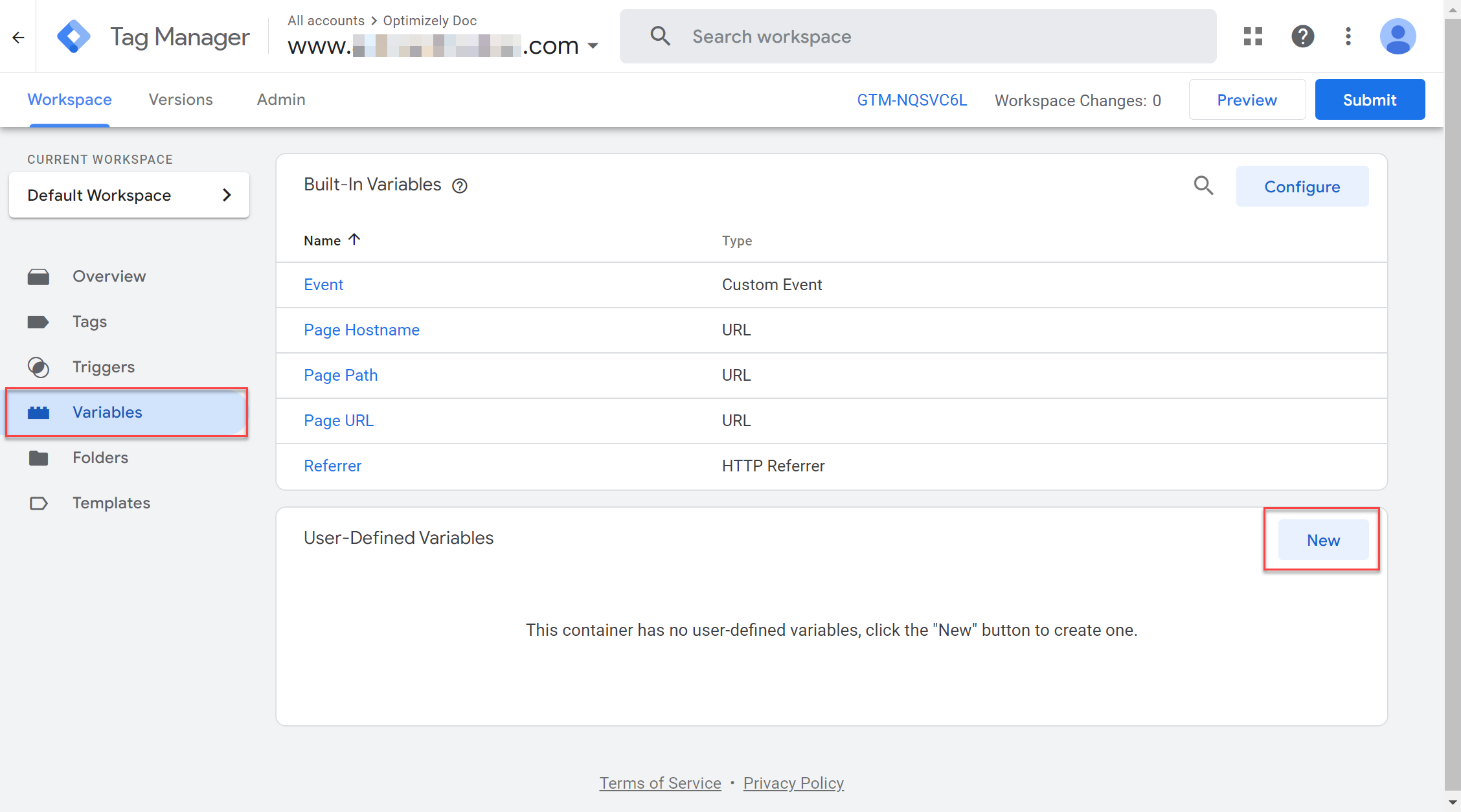
-
Enter Optimizely - flagKey in the variable's name field.
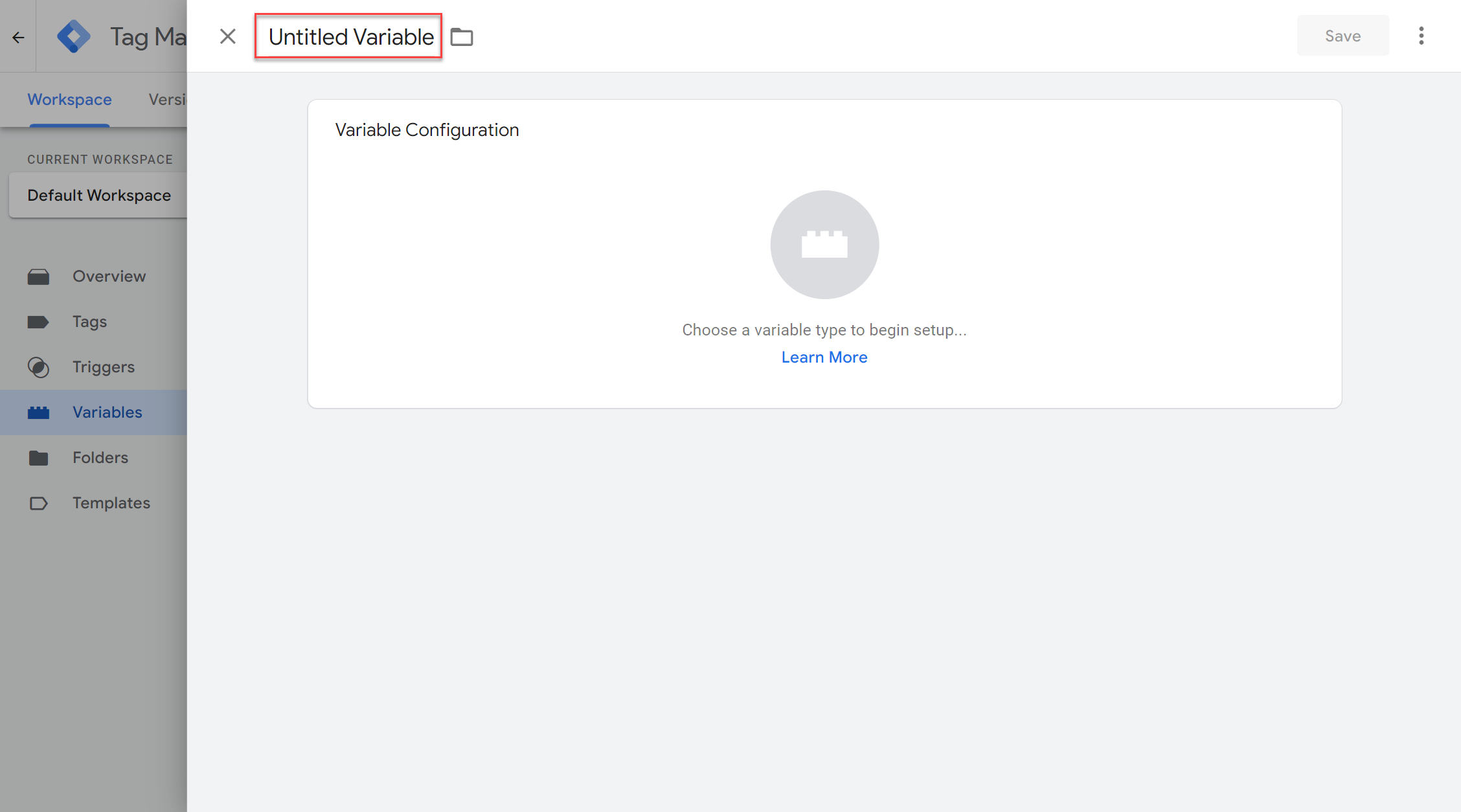
-
Click Variable Configuration and select Data Layer Variable.
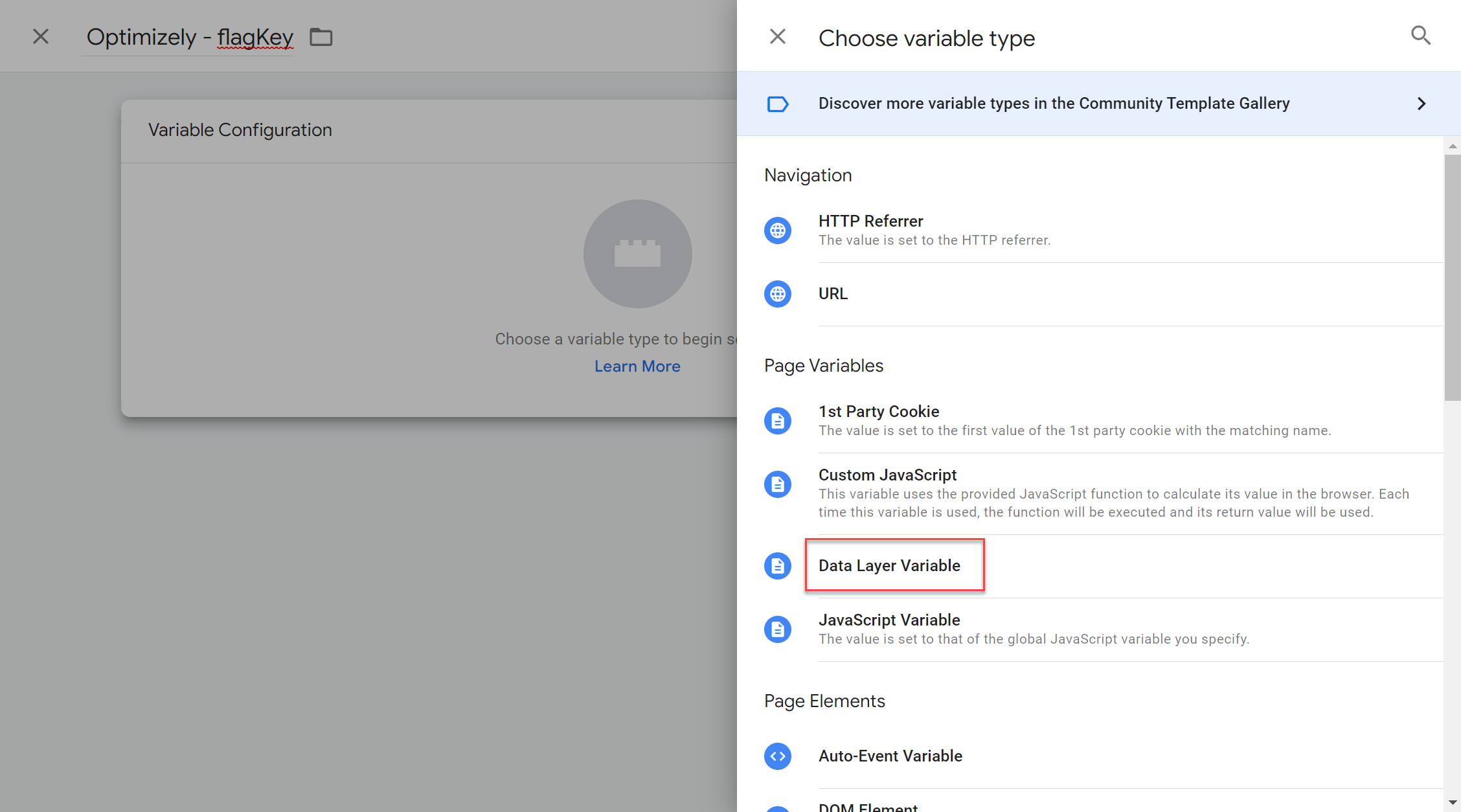
-
In the Data Layer Variable Name field, enter optimizely-flagKey.
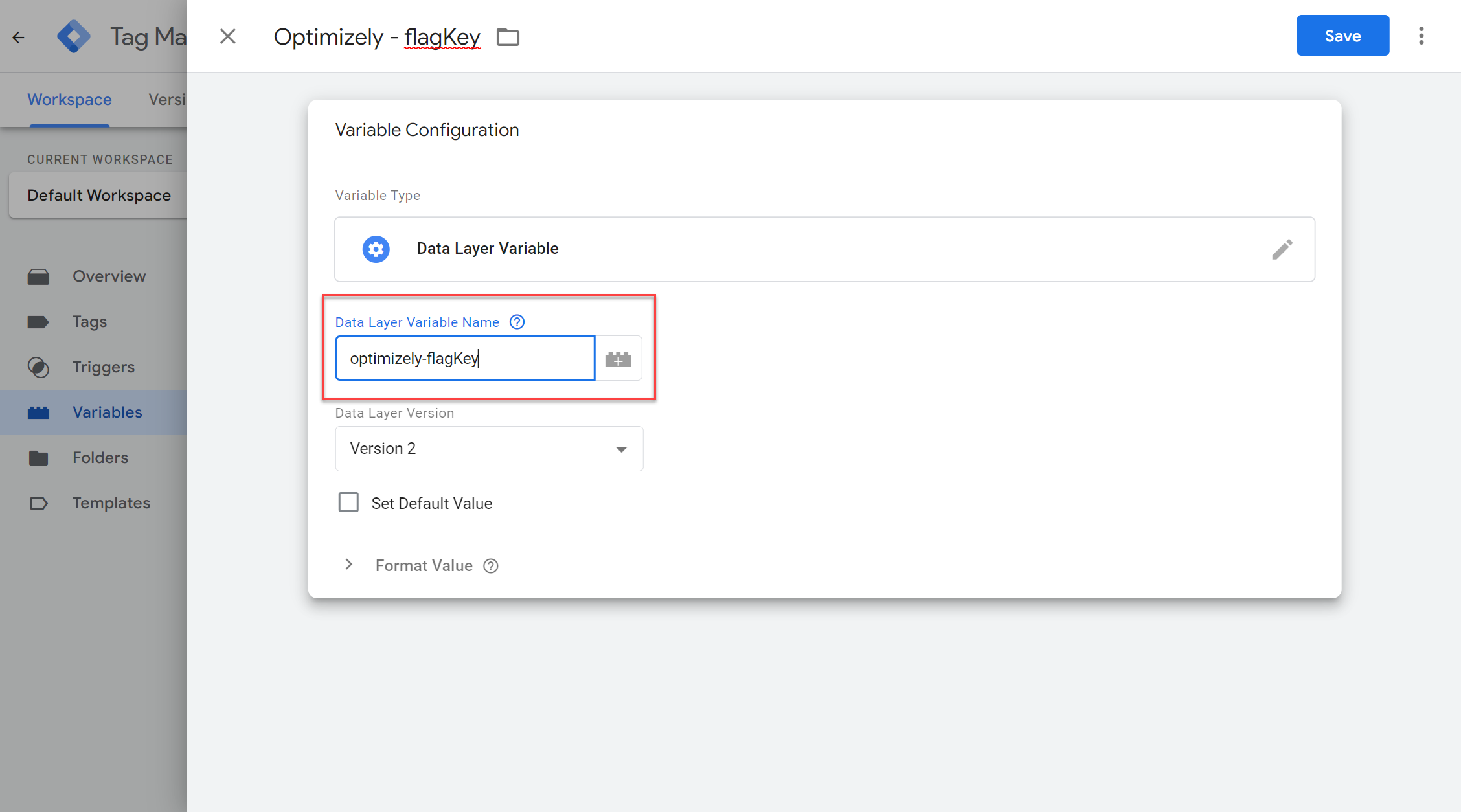
-
Click Save.
-
Repeat steps one through five to create a ruleKey and variationKey data layer variable with the following information:
Variable Variable name Data layer variable name ruleKey Optimzely - ruleKey optimizely-ruleKeyvariationKey Optimizely - variationKey optimizely-variationKey
When completed, you should have the following user-defined data layer variables:
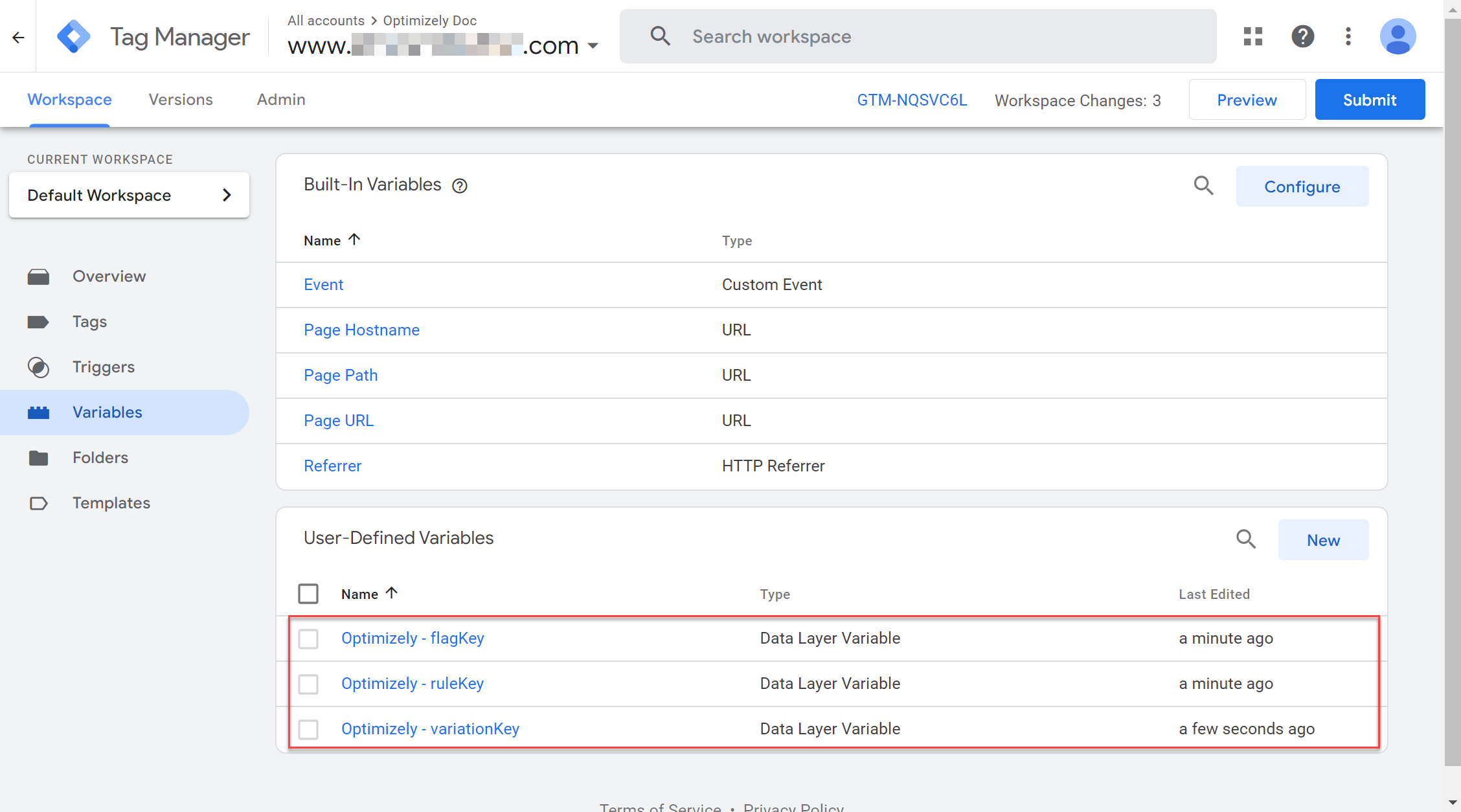
Configure the configuration tag in GTM
-
Go to Workspace > Tags > New.
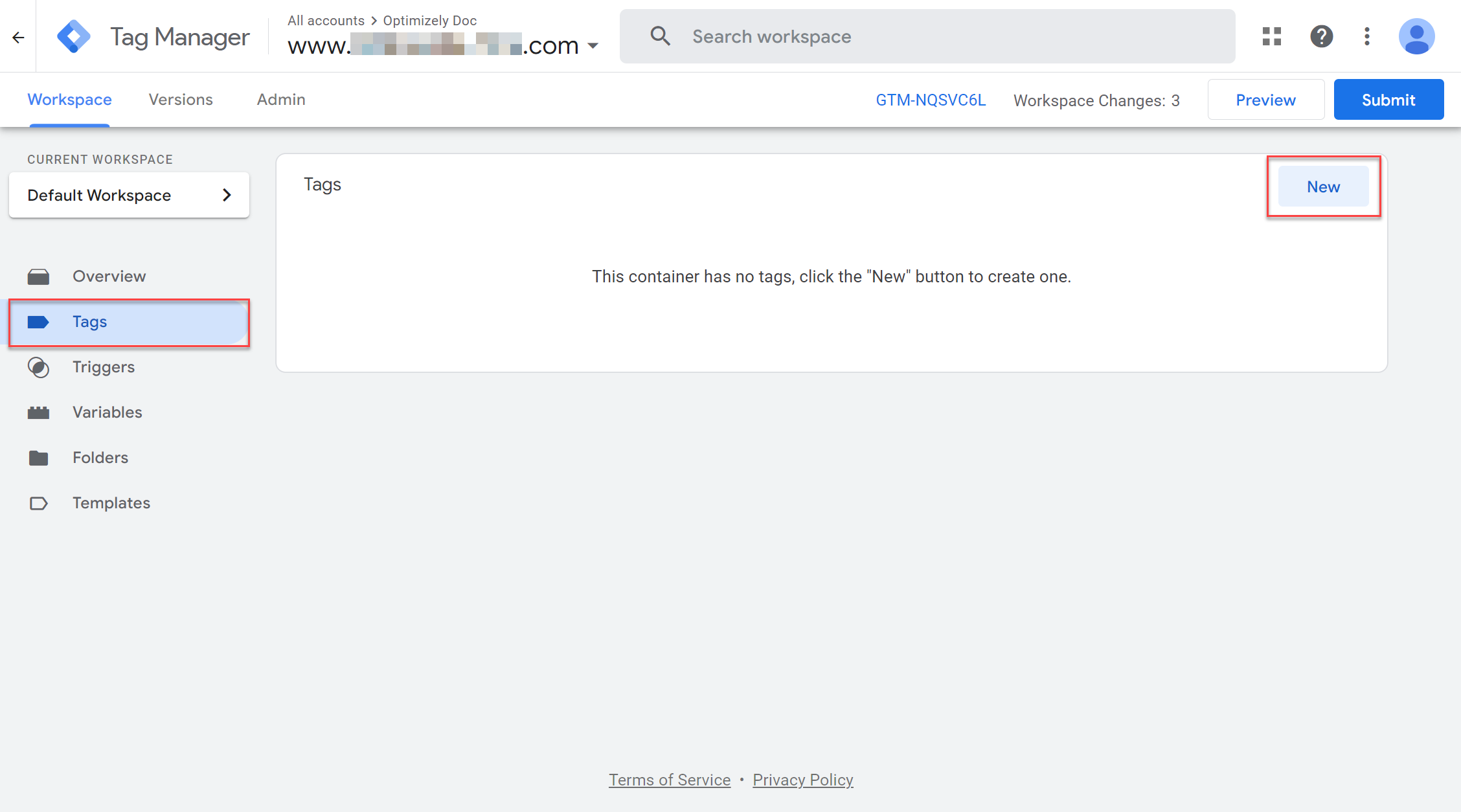
-
Enter Google Analytics GA4 Configuration in the name field.
-
Click Tag Configuration and select Google Analytics: GA4 Configuration.
Enter your Measurement ID. For information on where to find your Measurement ID, refer to the GA4 documentation.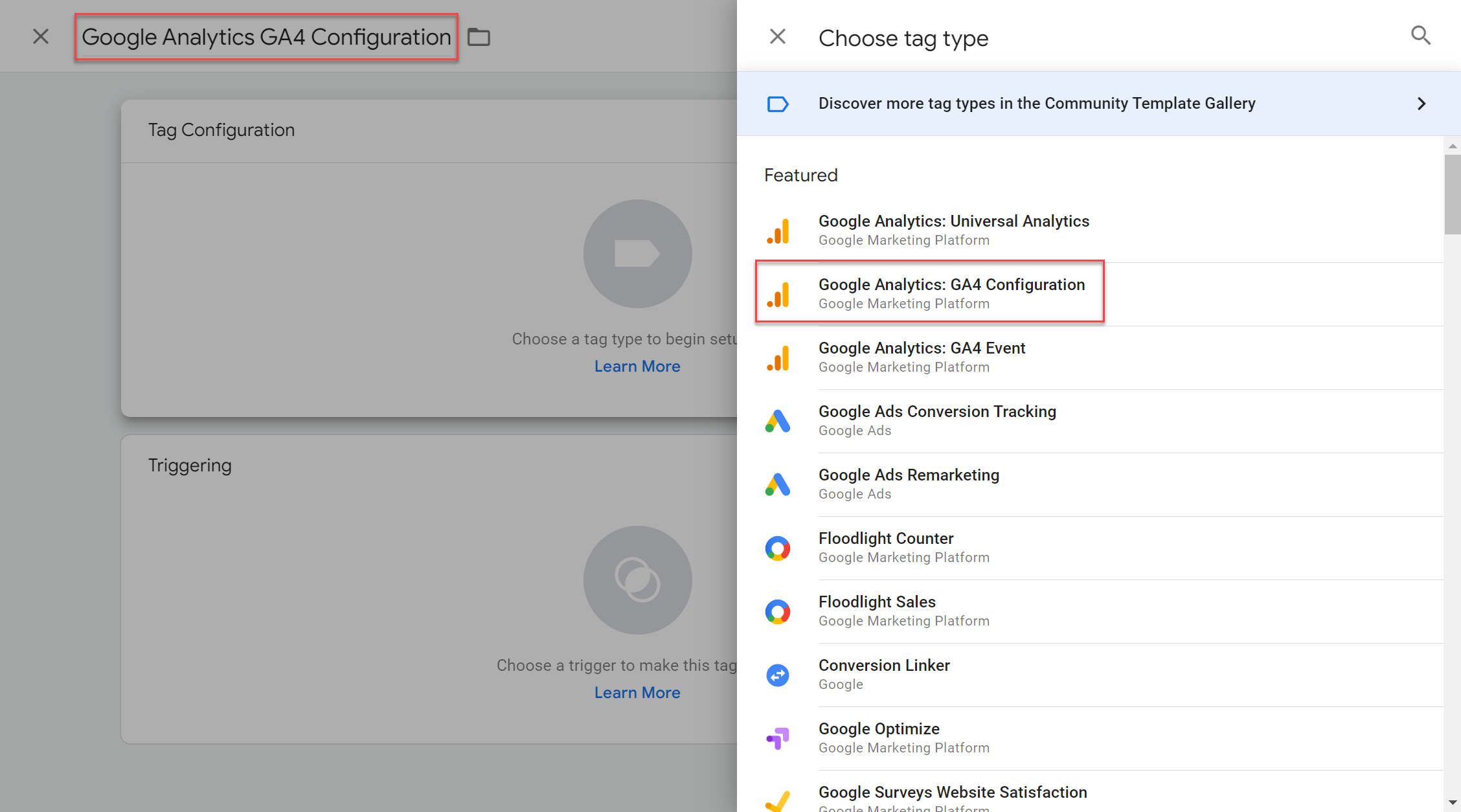
-
Click Triggering and select Initialization - All Pages.
-
Click Save.
Configure the event tag in GTM
-
Go to Workspace > Tags > New.
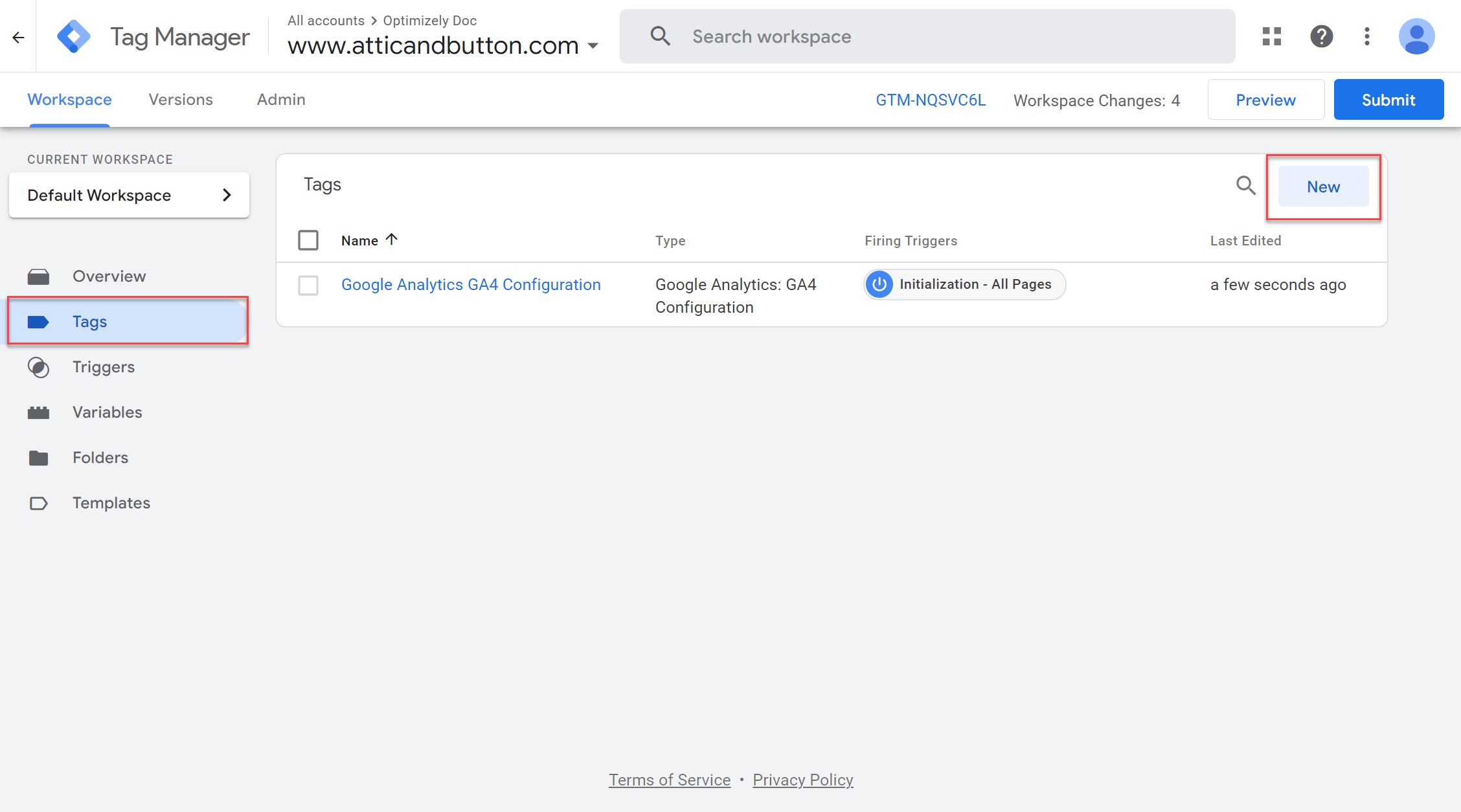
-
Enter Optimizely - GA4 EventUpdate in the name field.
-
Click Tag Configuration and select Google Analytics: GA4 Event.
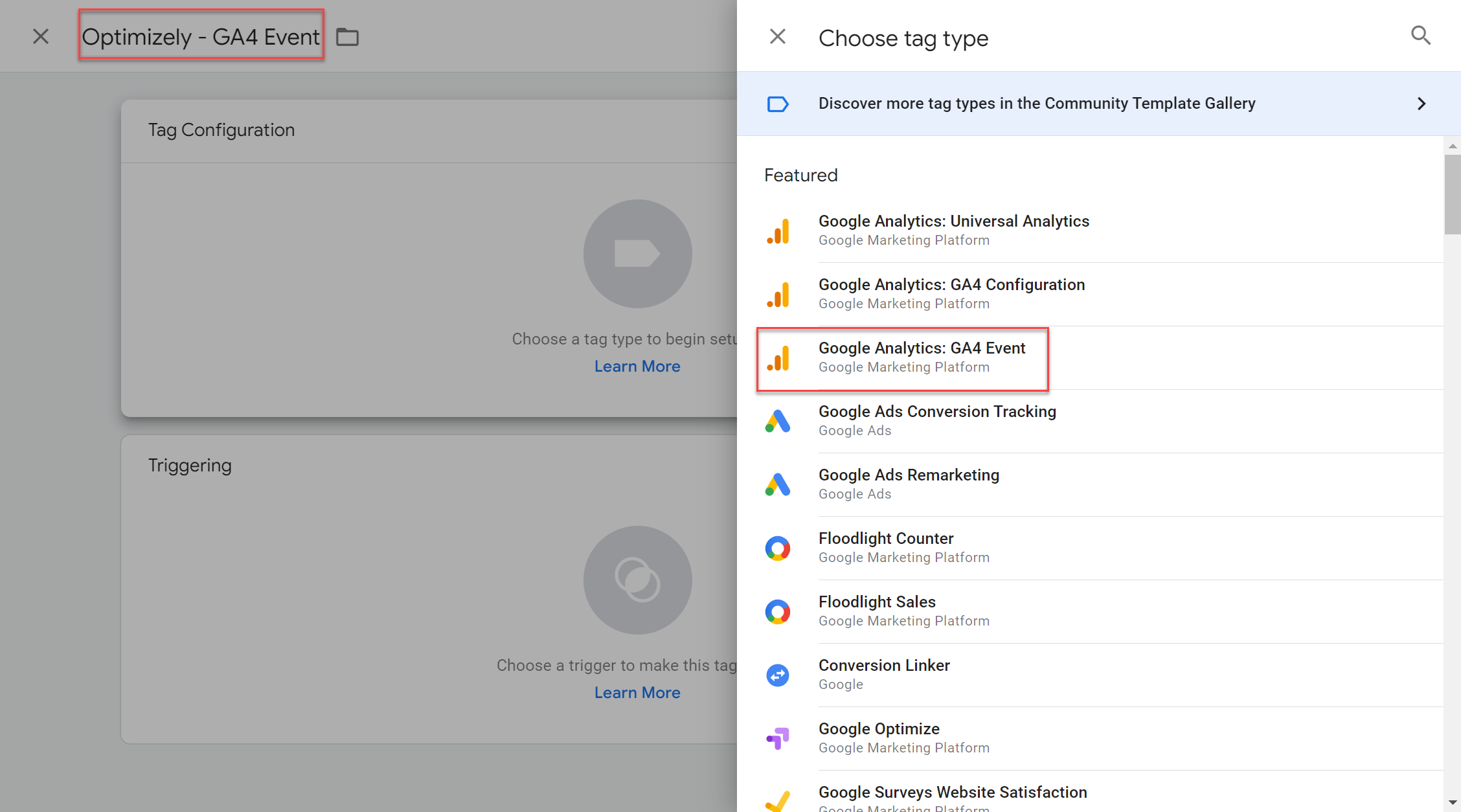
NoteIf you plan on creating both an Optimizely Web Experimentation experiment and an Optimizely Feature Experimentation experiment, you may want to differentiate between your projects.
As a best practice, name your event:
optimizely-decision-fsfor Feature Experimentation andoptimizely-decision-webfor Web.For instructions on setting up Optimizely Web Experimentation and GA4, please review the corresponding documentation:
- Enter optimizely-decision-fs in the Event Name field.
- Select Google Analytics GA4 Configuration in the Configuration Tag drop-down menu.
- Expand Event Parameters.
a) Select Add Row.
b) EnterFlagin the Parameter Name field.
c) In the Value field, select the Choose a Variable icon and select Optimizely - flagKey, which you created in Step two.
d) Repeat steps a-c forRuleandVariation, selecting the corresponding data layer variable for each.
When complete, your Tag Configuration should look like the following:
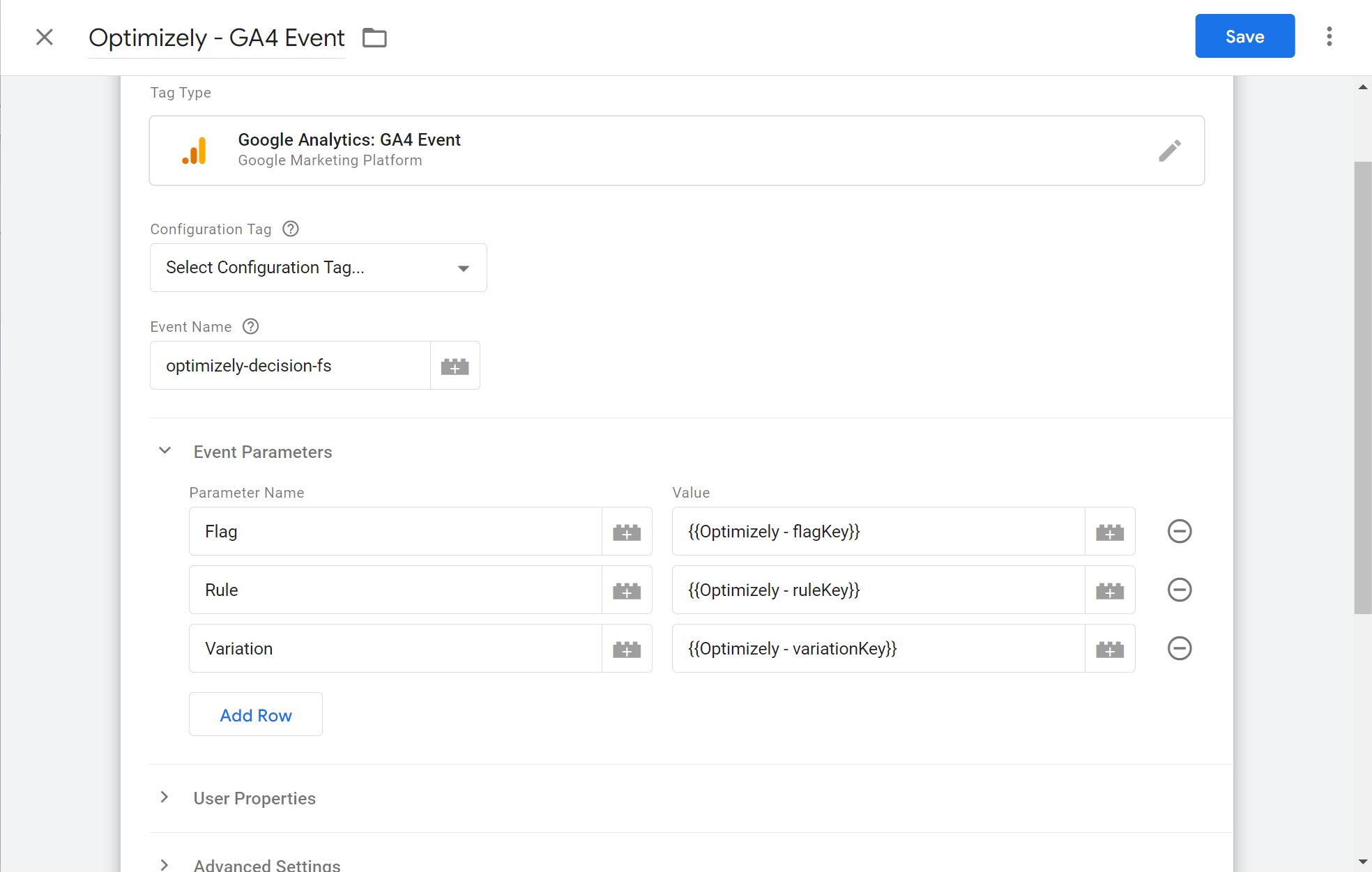
-
Click Triggering and click New Trigger (+) to create the following trigger:
a) Enter Optimizely - GA4 Trigger as the trigger name.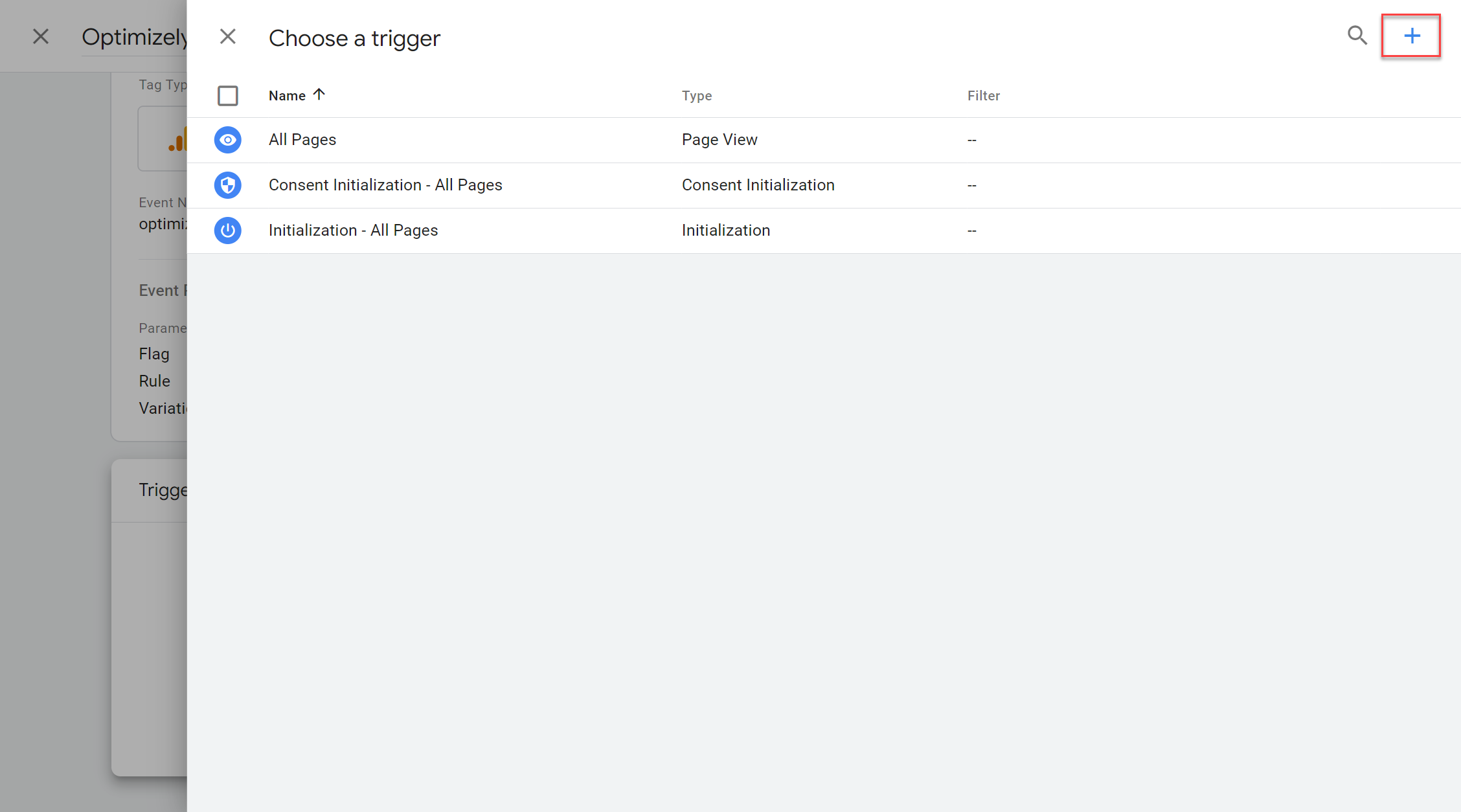
b) Click Trigger Configuration, scroll down, and select Custom Event.

c) In the Event name field, enter optimizely-decision-fs. Click Save.
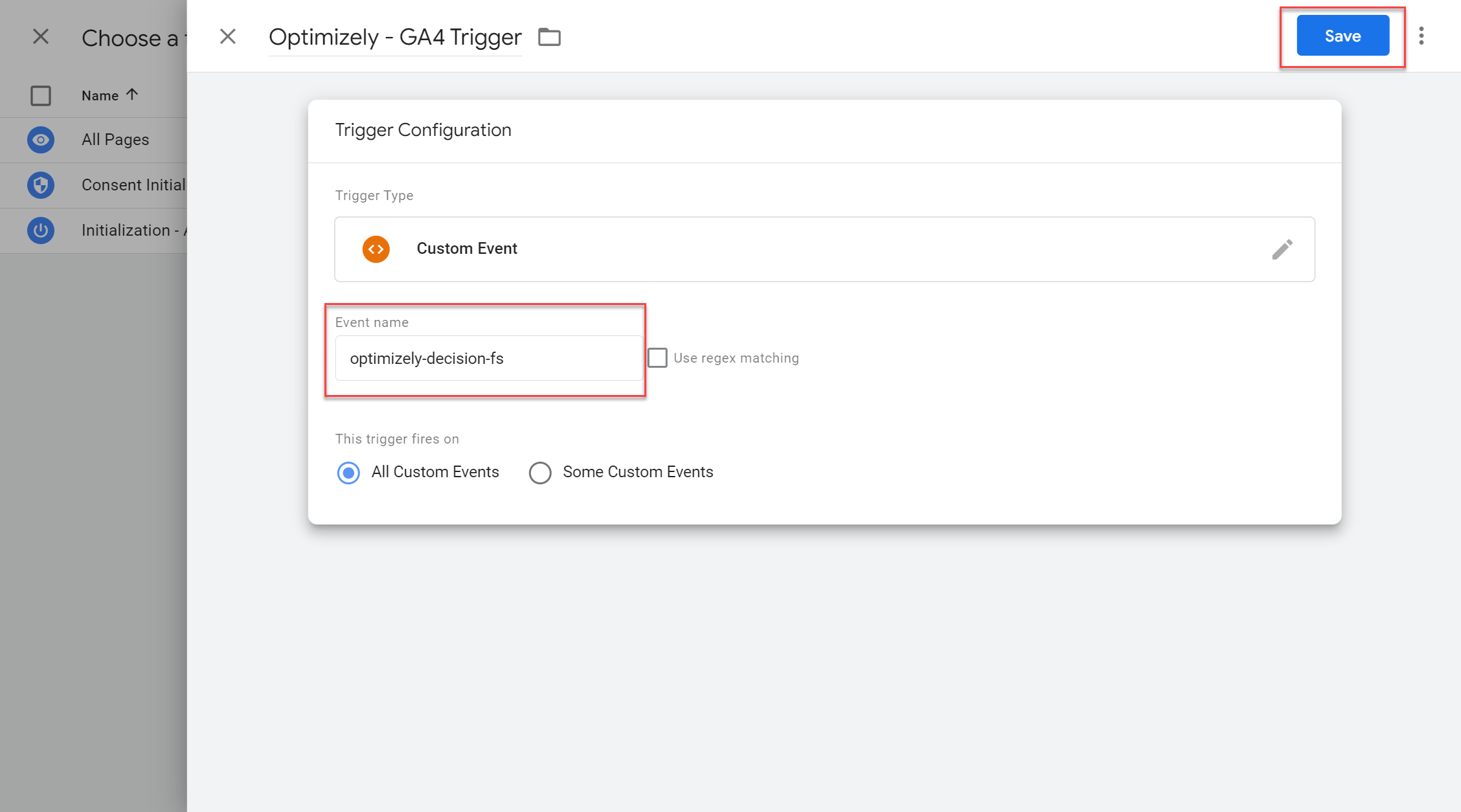
d) Then click Save again on the overall tag configuration page.
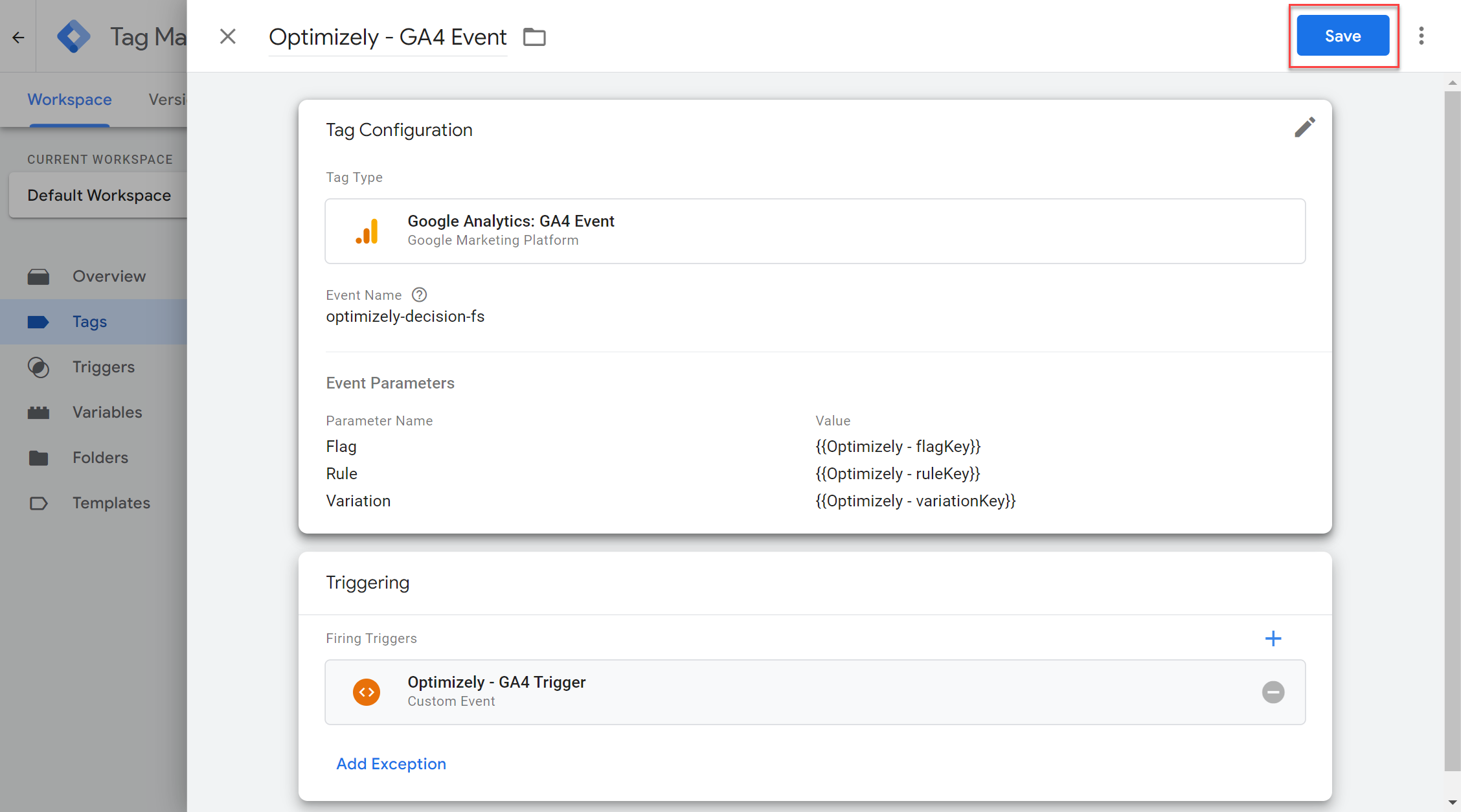
Submit and publish GA workspace
Submit and publish your workspace changes by going to Workspace > Submit > Publish (adding any details you would like to the Submission Configuration).
You are then able to see results in the events being populated in GA.
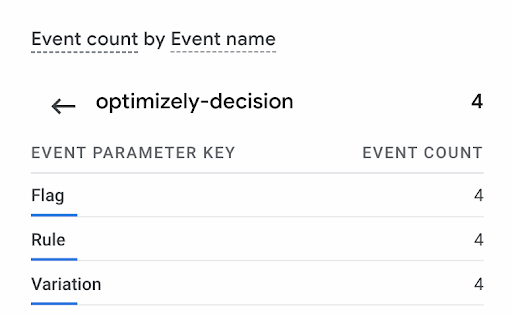
With their sent values.
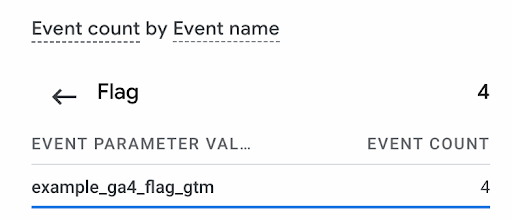
This can be verified by viewing the Realtime overview in the Reports tab of GA4.
Without GTM
You can directly push events to GA4 without using GTM, but tracking the events and variables sent by Optimizely Feature Experimentation is significantly more complicated.
To send Optimizely Feature Experimentation data to GA4, you use GA4’s Send events methods. For information, refer to GA4’s complete documentation on its send events methods.
Prerequisites
- Ensure that
gtagis defined. - Ensure you have GA4 initialized and ready to interpret variables returned by Optimizely Feature Experimentation.
For the JavaScript example, you would use the GA4 send events call. You would add the following sample call to your code base:
gtag("event", "optimizely-decision", {
Flag: decisionInfo.flagKey,
Rule: decisionInfo.ruleKey,
Variation: decisionInfo.variationKey
});Within GA4, you can name your variables whatever you would like. You can remove or include any variables. But for a flag rule, you should use the following:
flagKeyruleKeyvariationKey
Conclusion
After configuring and pushing events from Optimizely Feature Experimentation to GA4, the next step is to create segments in GA. Segments are a subset of your analytics data. Review the Create segments for Google Analytics 4 documentation for complete instructions.
Updated 3 days ago